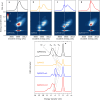Accessing metal-specific orbital interactions in C-H activation with resonant inelastic X-ray scattering
- PMID: 38362433
- PMCID: PMC10866335
- DOI: 10.1039/d3sc04388f
Accessing metal-specific orbital interactions in C-H activation with resonant inelastic X-ray scattering
Abstract
Photochemically prepared transition-metal complexes are known to be effective at cleaving the strong C-H bonds of organic molecules in room temperature solutions. There is also ample theoretical evidence that the two-way, metal to ligand (MLCT) and ligand to metal (LMCT), charge-transfer between an incoming alkane C-H group and the transition metal is the decisive interaction in the C-H activation reaction. What is missing, however, are experimental methods to directly probe these interactions in order to reveal what determines reactivity of intermediates and the rate of the reaction. Here, using quantum chemical simulations we predict and propose future time-resolved valence-to-core resonant inelastic X-ray scattering (VtC-RIXS) experiments at the transition metal L-edge as a method to provide a full account of the evolution of metal-alkane interactions during transition-metal mediated C-H activation reactions. For the model system cyclopentadienyl rhodium dicarbonyl (CpRh(CO)2), we demonstrate, by simulating the VtC-RIXS signatures of key intermediates in the C-H activation pathway, how the Rh-centered valence-excited states accessible through VtC-RIXS directly reflect changes in donation and back-donation between the alkane C-H group and the transition metal as the reaction proceeds via those intermediates. We benchmark and validate our quantum chemical simulations against experimental steady-state measurements of CpRh(CO)2 and Rh(acac)(CO)2 (where acac is acetylacetonate). Our study constitutes the first step towards establishing VtC-RIXS as a new experimental observable for probing reactivity of C-H activation reactions. More generally, the study further motivates the use of time-resolved VtC-RIXS to follow the valence electronic structure evolution along photochemical, photoinitiated and photocatalytic reactions with transition metal complexes.
This journal is © The Royal Society of Chemistry.
Conflict of interest statement
The authors declare no conflicts interest.
Figures





Similar articles
-
K- and L-edge X-ray Absorption Spectroscopy (XAS) and Resonant Inelastic X-ray Scattering (RIXS) Determination of Differential Orbital Covalency (DOC) of Transition Metal Sites.Coord Chem Rev. 2017 Aug 15;345:182-208. doi: 10.1016/j.ccr.2017.02.004. Epub 2017 Feb 9. Coord Chem Rev. 2017. PMID: 28970624 Free PMC article.
-
Metal-ligand covalency of iron complexes from high-resolution resonant inelastic X-ray scattering.J Am Chem Soc. 2013 Nov 13;135(45):17121-34. doi: 10.1021/ja408072q. Epub 2013 Nov 4. J Am Chem Soc. 2013. PMID: 24131028 Free PMC article.
-
Tracking C-H activation with orbital resolution.Science. 2023 Jun 2;380(6648):955-960. doi: 10.1126/science.adf8042. Epub 2023 Jun 1. Science. 2023. PMID: 37262165
-
Capturing Atom-Specific Electronic Structural Dynamics of Transition-Metal Complexes with Ultrafast Soft X-Ray Spectroscopy.Annu Rev Phys Chem. 2022 Apr 20;73:187-208. doi: 10.1146/annurev-physchem-082820-020236. Epub 2022 Jan 5. Annu Rev Phys Chem. 2022. PMID: 34985923 Review.
-
Computational approaches for XANES, VtC-XES, and RIXS using linear-response time-dependent density functional theory based methods.Phys Chem Chem Phys. 2022 Jun 22;24(24):14680-14691. doi: 10.1039/d2cp01132h. Phys Chem Chem Phys. 2022. PMID: 35699090 Review.
Cited by
-
Coupling experiment and theory to push the state-of-the-art in X-ray spectroscopy.Nat Rev Chem. 2025 Jul;9(7):436-453. doi: 10.1038/s41570-025-00718-2. Epub 2025 May 30. Nat Rev Chem. 2025. PMID: 40447841 Review.
References
-
- Arndtsen B. A. Bergman R. G. Mobley T. A. Peterson T. H. Acc. Chem. Res. 1995;28:154–162. doi: 10.1021/ar00051a009. - DOI
-
- Lees A. J. Purwoko A. A. Coord. Chem. Rev. 1994;132:155–160. doi: 10.1016/0010-8545(94)80035-9. - DOI
-
- Lenges C. P. Brookhart M. J. Am. Chem. Soc. 1999;121:6616–6623. doi: 10.1021/ja990702s. - DOI
LinkOut - more resources
Full Text Sources
Miscellaneous

